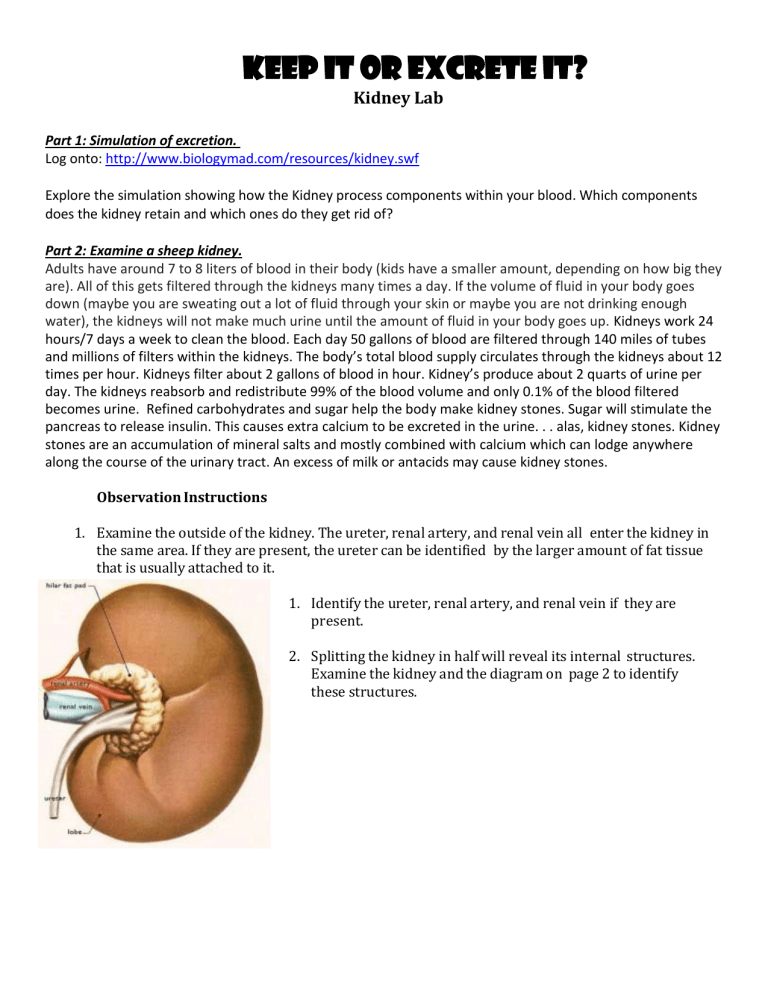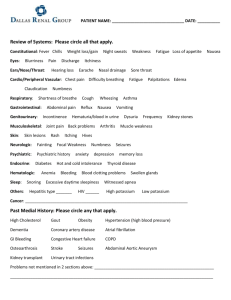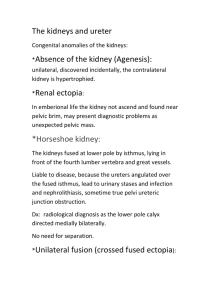KidneyDissectionGuide

Keep it or excrete it?
Kidney Lab
Part 1: Simulation of excretion.
Log onto: http://www.biologymad.com/resources/kidney.swf
Explore the simulation showing how the Kidney process components within your blood. Which components does the kidney retain and which ones do they get rid of?
Part 2: Examine a sheep kidney.
Adults have around 7 to 8 liters of blood in their body (kids have a smaller amount, depending on how big they are). All of this gets filtered through the kidneys many times a day. If the volume of fluid in your body goes down (maybe you are sweating out a lot of fluid through your skin or maybe you are not drinking enough water), the kidneys will not make much urine until the amount of fluid in your body goes up. Kidneys work 24 hours/7 days a week to clean the blood. Each day 50 gallons of blood are filtered through 140 miles of tubes and millions of filters within the kidneys. The body’s total blood supply circulates through the kidneys about 12 times per hour. Kidneys filter about 2 gallons of blood in hour. Kidney’s produce about 2 quarts of urine per day. The kidneys reabsorb and redistribute 99% of the blood volume and only 0.1% of the blood filtered becomes urine. Refined carbohydrates and sugar help the body make kidney stones. Sugar will stimulate the pancreas to release insulin. This causes extra calcium to be excreted in the urine. . . alas, kidney stones. Kidney stones are an accumulation of mineral salts and mostly combined with calcium which can lodge anywhere along the course of the urinary tract. An excess of milk or antacids may cause kidney stones.
Observation Instructions
1.
Examine the outside of the kidney. The ureter, renal artery, and renal vein all enter the kidney in the same area. If they are present, the ureter can be identified by the larger amount of fat tissue that is usually attached to it.
1.
Identify the ureter, renal artery, and renal vein if they are present.
2.
Splitting the kidney in half will reveal its internal structures.
Examine the kidney and the diagram on page 2 to identify these structures.
3.
There are several parts to the kidney, as show at right. From the outside to the center of the kidney, find each of the following in your specimen:
The renal cortex is the solid- looking outermost part of the kidney. It contains many small arteries and veins that carry blood to and from nephron s.
Approximately one million nephrons are located in the cortex.
The medulla is the region located inward from the cortex. It includes the cone-shaped renal
pyramids. These are the fibrous or striped triangular zones in the medulla that contain the colleting ducts, which collect urine from the kidney tubules of the nephrons in the cortex.
Between the pyramids are the renal columns that contain middle-sized arteries and veins that carry blood between the nephrons in the cortex and the renal artery and vein.
The hollow area in the center of the kidney is the renal pelvis, which should not be confused with the bone called the pelvis. The collecting ducts drain into the pelvis. From there, the urine passes out through the ureter to the urinary bladder.
4.After you have identified all the structures in the kidney, work with your group to trace the path taken through your group’s kidney by the blood, and by the filtrate that becomes the urine. As you do this, point out and name all the structures that are involved. When your group is satisfied that you can do this well, diagram the kidney in your notebook, label
the parts, and trace the pathway of blood through the kidney with a highlighter.
5.After your group has finished, wash your hands well with soap and water.
6.Your group should answer the following questions in your notebook.
1.
What is the main function of the kidney?
2.
Describe the pathway of blood through the kidney.
3.
How much blood is filtered per hour? How much urine is produced in one day?
4.
What is reabsorption?
5.
What are components the kidney will reabsorb and why?
6.
What are components that the kidney will get rid of and why?
7.
What are components in which the kidney will keep some, but also get rid of some and why?
8.
In which part of the kidney does the majority of water reabsorption occur?
9.
What structure carries urine out of the kidney and where does it go?
10.
What is a kidney stone?









